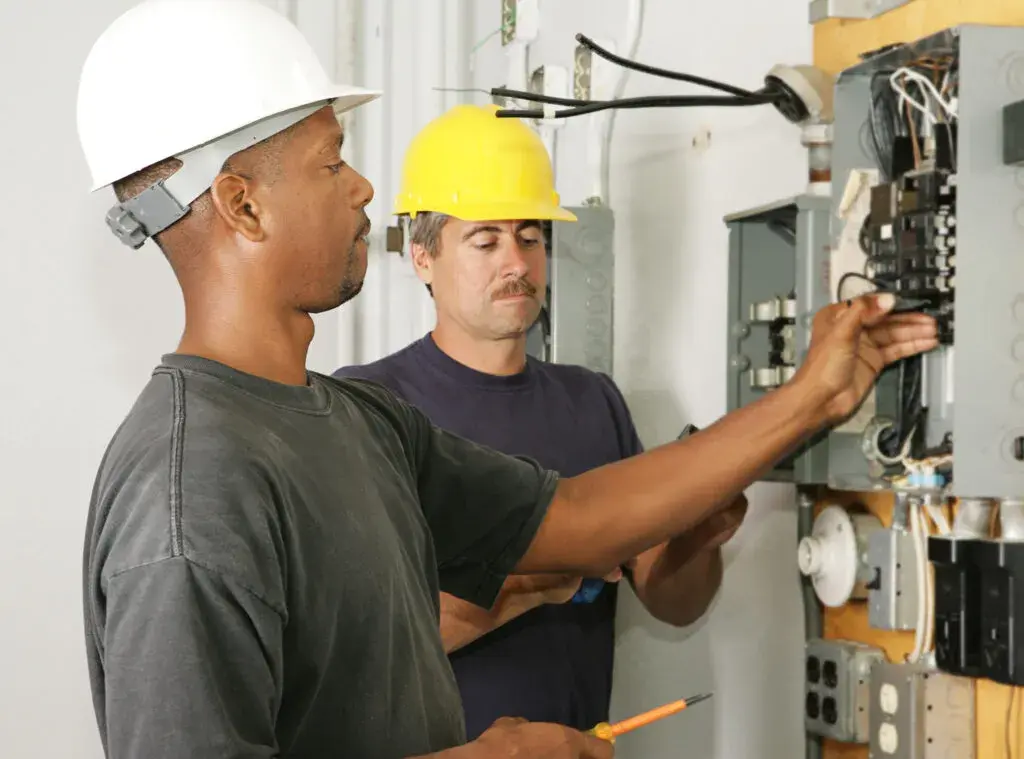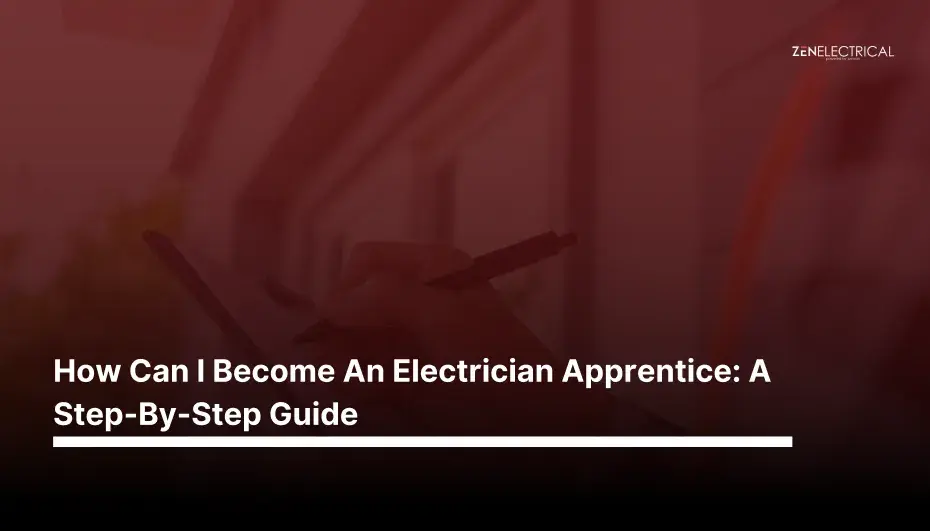How Can I Become An Electrician Apprentice: A Step-By-Step Guide
- ZenElectrical
- 9 Min Read
In the quest to become a skilled field service technician in the electrical field and get quality electrician jobs, one must go through career training programs.
This ensures that booming electricians are equipped with the necessary theoretical and practical knowledge before they are self-sufficient enough to handle real-life complex electrical projects independently.
In short, to become an electrician, you first need to become an apprentice electrician. And this is exactly what we will be guiding you on today.
In this blog post, we will provide you with a comprehensive guide on how to get into an electrician apprenticeship program and become an electrician apprentice in easy steps.

Here What We Cover
What Is An Electrician Apprentice?
An electrician apprentice is an entry-level position for trainee electricians who wish to learn about the trade while earning and providing services. They usually work under the supervision of either journeymen or master electricians.
Before you start your journey as an electrician, the first and foremost step is to gain hands-on training as an electrician apprentice. Being an electrician apprentice means you are both a student and a technician in training, prepping up for the complex projects you need to take on years later.
In this phase, you are usually trained under the guidance of a senior electrician, either a journeyman electrician or a master electrician. The main objective of going through an apprenticeship program is to gain enough knowledge and expertise to work as a licensed electrician.

Use our free estimate template now
Make winning quotes in minutes—for any industry and any job.
Roles and Responsibilities Of An Apprentice Electrician
As an apprentice electrician, your duty is to mainly assist the senior electricians and learn the trade practically.
In the apprenticeship program, you will be exposed to various theoretical classroom training along with practical projects that enhance your skillsets and expertise.
The basic roles and duties of an apprentice electrician include:
Interpreting blueprints
Securing materials and tools
Assisting senior electricians on the field
Working on wiring systems
Replacing component parts
Assessing reasons for system malfunctions
These are a few of the roles and responsibilities that an average apprentice electrician performs on a daily basis.
They are also required to be thorough with theoretical concepts and the National Electrical Code (NEC), which is a major requirement once they reach the stage of a journeyman or master electrician.
What are the most popular apprenticeship programs in the United States?
Getting into an apprenticeship program can be challenging, but with the right steps and guidance, it can be a piece of cake.
There are many popular electrician apprenticeship programs in the United States, such as:
ETA (by IBEW and NECA)
ETA, or Electrical Training Alliance, was formed by the International Brotherhood of Electrical Workers (IBEW) and the National Electrical Contractors Association (NECA). ETA has developed multiple training programs for various specializations, such as inside wiremen, outside linemen, and many more. Here’s our go to guide to become an IBEW apprentice, to understand better how ETA works.
IEC
Independent Electrical Contractors (IEC) onboard America’s leading professional instructors to help aspiring electricians get their hands on the industry’s best electrical curriculum. Here, they equip you with hands-on-the-job training and an interactive learning experience, gearing you up for the complex electrical issues you may find in the real world.
ABC
Associated Builders and Contractors (ABC) equips aspiring electricians with quality education and the right training. This assists them as they sail through their training years and provides them with a solid base for a robust career path in the field of electrical services.
These are the most popular options for an electrician apprenticeship program in the US.
Getting into these apprenticeship programs can be competitive. But if you are serious about your chosen career path, passionate about electrical systems, and want to enhance your skill set in this field, you can easily get into one of these and get the right training to headstart your career in this field.
Am I Eligible For An Apprenticeship Program?
To be eligible for an apprenticeship program in the USA, certain basic requirements need to be fulfilled before applying for one of the programs. These include:
At least 18 years of age
A high school diploma or GED
A driver’s license or proof of vehicle ownership
Drug test pass certificate
You don’t require a high school diploma or a drug test pass certificate as mandatory documents. It depends on the requirements of the specific criteria of the apprenticeship program you are enrolling in.
Hence, contacting them and getting familiar with all qualifications and documentation requirements is recommended.
Get posts like this in your inbox.
Keep learning how to run a 5-star business with our bi-weekly newsletter.
How To Get Into An Electrician Apprenticeship Program?
Once you have verified all the requirements and eligibility criteria from the institution, it’s time to prepare to enroll in an apprenticeship program.
Even though the enrollment process in apprenticeship programs can be competitive, with the proper preparation and mindset, you can still crack it easily.
Step 1: Select the relevant program
Apprenticeship programs offer various electrician apprentice programs with specialization courses in residential, commercial, or industrial electrician, lineman, wireman, etc.
Plan your career trajectory and what kind of expertise you would want to gain from this training. Ensure that the program you select helps you advance your career as an electrician.
Hence, choose your program wisely, considering that you will study the same for the next 4 to 5 years.
Step 2: Prepare your application
Before taking the written test, you must draft an application for the program you want to enroll in. Your application should contain all necessary documents to validate your identity, address, and preliminary qualifications.
Generally, some basic documents that you may require are:
high school certificate
birth certificate
drivers license
drug test certificate
vehicle insurance or ownership certificate
Get familiar with the necessary documents required by your institution and keep them ready and organized to avoid last-minute hassle.
Step 3: Prepare for the examination and interview round
Once you have submitted your enrollment application, the subsequent step would be to start preparing for the written test and interview process.
You will have the written test first, with questions covering the basics of maths with algebraic and mechanical equations, followed by reading comprehension. This test is to assess your basic concepts and knowledge level.
Hence, it’s imperative that you prepare yourself for the test meticulously.
There are various mock tests available on the internet that can help you practice and monitor your time management skills.
It’s not just the knowledge that is the vital part; also, how you manage to answer the questions in a limited timeframe is more crucial. So, make sure to keep an eye on both aspects to be fully prepared.
You are eligible for the interview round only after you pass your written test. You will be asked your reasons for joining the apprenticeship program and your skills as an electrician.
Questions you might be asked:
Reason for applying for the apprenticeship program
Project details of a job or service from start to finish
Details of a job or a project where you needed to collab
How you would go about a job if you are unclear with the instructions
Incident details of a job or service gone wrong
Step 4: Wait for your results
Results may take time to come, perhaps a week or two. Generally, it’s challenging to crack an apprenticeship entry test and interview the first time.
Congratulations if you manage to ace both of them, as you can immediately get started on your apprenticeship journey. Or at least start gearing up for it.
If not, don’t lose hope. You can always try again a second time. Taking the test a second time could showcase your commitment and focus on pursuing an electrical career, which can impress the interviewees.
Step 5: Get started on your apprenticeship journey
Once selected for the program, make sure you’re serious and focused enough to get the best out of your time and energy.
Adequate training and classroom instruction will be provided to help you gain the expertise you need to start working as a licensed electrician.
Make sure not to take it for granted, as there is more demand for these programs, which makes you lucky enough to be even there in the first place.
Benefits Of Enrolling In An Apprenticeship Program
Enrolling in an apprenticeship program equips you with the skills and training that will help you become a licensed electrician.
It is like the first step you take to make it a rewarding career, and ample job security will help you stay motivated throughout your journey.
Some evident benefits of getting into an apprenticeship program include:
On-the-job training working on real-life projects
Earn stipend for projects while still learning as a student
Connect with field experts and contractors, helping you build connections
Learn practical skills working under the guidance of senior electricians
Get certifications and post-training placement opportunities
Do I need to enroll in a pre-apprenticeship program before this?
Pre-apprenticeship programs can indeed increase your chances of getting into your preferred apprenticeship programs; however, they are not really mandatory.
In some cases, pre-apprenticeship programs can help you advance to mid-level expertise without a full-fledged apprenticeship. But the only drawback is that you probably won’t be paid according to the standards of an actual apprenticeship program.
Some apprenticeship programs combine a pre-apprenticeship course, which can be great for showcasing your commitment to the field; however, attending just the apprenticeship can prove enough to upskill yourself for the career.
Which one should I choose - An apprenticeship program or a trade school?
Most aspiring electricians have a common question: whether to join a trade school or an apprenticeship program. Ideally, enrolling in an apprenticeship program has more pros than enrolling in a trade school.
Apprenticeship programs offer students stiped-based projects while they are still being trained as students. In comparison, getting into a trade school can be expensive but provides extensive learning opportunities.
What's Next After Apprenticeship?
Once you have completed your apprenticeship program, the next step is getting your journeyman license and working on projects as a mid-level electrician; this license also opens your way for a salary increase..
The minimum qualifications and requirements to work as a journeyman electrician are a minimum of 8000 hours of on-field training along with 700 to 800 classroom instruction sessions.
Once you have gained an additional 4000 hours of electrical work experience as a journeyman, you can take the test for a master electrician license and start working as an independent electrician apprentice.
Alternatively, you can decide to start your own electrical contractor business and enjoy significant revenue.

Explore a better way to grow your business. Book a free demo now!
Get organized, win jobs, and wow customers.
Book A Free Demo with ZenTrades Today!
Related Reading
Why Your Field Software Management Software Needs QuickBooks Integration
ZenTrades Why Your Field Service Management Software Needs QuickBooks Integration Read More Request Demo...
Read MoreZenTrades How To Manage Electrical Service Agreements Like...
Read MoreZenTrades The Best 5 Jobber Alternatives In 2023...
Read More


